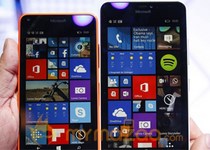Microsoft is not a force in phones and never has been. The software giant’s $7.6 billion write-off of its phone business makes it even less likely now that consumers will opt for its phones.
The Windows Phone platform is projected to have about 3 percent of the global phone market in 2015, according to market researcher IDC. That compares to about an 80 percent share for Android and over 16 percent for Apple (iOS).
With Android and Apple controlling the global phone market, that leaves very little for Microsoft to build a consumer phone business on. So, here’s a tough question for consumers: Would you buy a phone from a company that has just stated, however elliptically, that its consumer phone strategy is a bust?
“In the near term, we will run a more effective phone portfolio, with better products,” said CEO Satya Nadella in a statement last week announcing the $7.6 billion charge.
Microsoft bought Nokia’s mobile business back in September 2013 for about $7.2 billion with then-CEO Steve Ballmer proclaiming that “it’s a bold step into the future.”
We know now that turned out to be a “bold” misstep but the fact remains that Microsoft will continue to sell phones including “flagship devices” that “Windows fans” will “love,” according to Nadella’s statement. The subtext seems to be that if you buy a Windows Phone today you won’t be left out in the cold. In other words, Microsoft isn’t abandoning its phone business wholesale, just refocusing its efforts.
That refocus includes business and flagship phones, though Nadella’s statement is remarkably vague about specifics.
Ambiguity aside, the fact is that Microsoft still offers a wide variety of phones, including the new Lumia 640 XL that serves, however temporarily, as a lower-end placeholder for the aging flagship, the Nokia Lumia 1020. On the spec front the 640 is not a stunner. And maybe that’s one of the problems. While the 5.7-inch display puts it into “phablet” territory (a popular phone category), the physical design is not going to win over any iPhone or Samsung Galaxy users. At 9mm thick it’s fatter than Apple’s or Samsung’s flagship phones and it’s made out of matte plastic. One recent review said “it certainly doesn’t feel like a premium phone.”
It does boast a 13MP main camera and is cheap, however. It can be bought outright for $249.99 or for 99 cents (phones from major suppliers don’t get much cheaper than that) with a two-year AT&T contract.
As is usually the case with struggling platforms, a wide range of popular apps are not available on
Windows Phone (which reflects the lack of apps that run on Windows 8.1’s “Metro,” aka Modern, touch-centric interface for PCs). Though that’s improving from the days of a Windows app store essentially devoid of any major apps, it’s not enough to make someone switch from iOS or Android.
To be sure, the Windows Phone 8.1 operating system — with its tiled interface and Cortana voice assistant — has its supporters. The sad part is that Nadella’s statement happened just before the upcoming July 29 release of Windows 10. If Windows Phone had been more successful, it would be a platform-affirming moment. Alas, that affirmation doesn’t seem to be in the cards.







